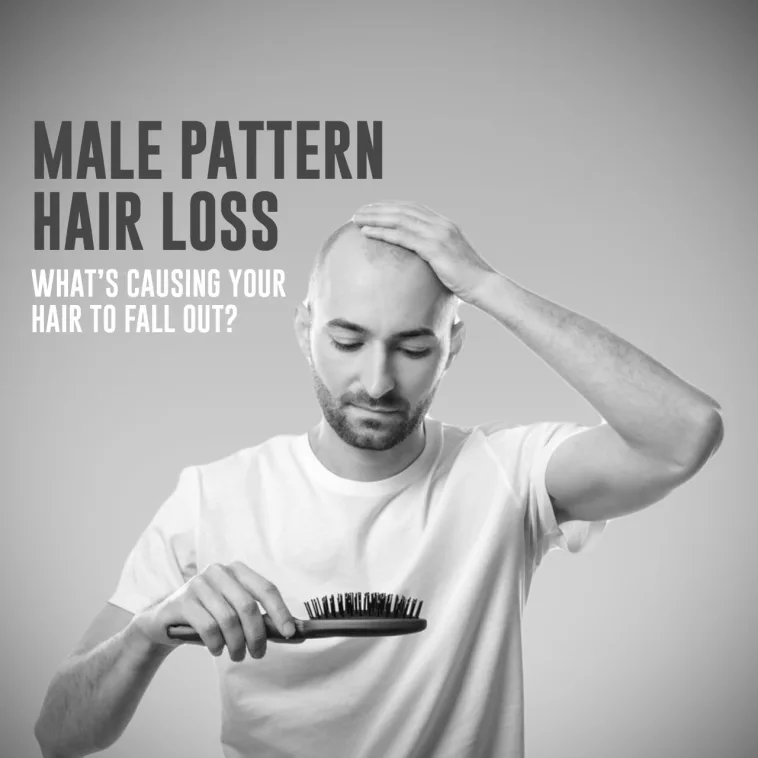Hair loss is a nightmare for everyone. No one would love to wake up and look in the mirror just to see a balding head. Unfortunately, around 50% of guys will experience hair loss at some point in their lives. Male pattern baldness is fairly prevalent, and many men in their early to mid-20s may experience it.
Hair loss may be distressing. It not only affects your appearance but also your self-esteem. According to studies, guys who experience hair loss experience depression, anxiety, and a lower sense of confidence than their peers who have a head full of hair.
In this post, we will address the most common kind of hair loss in men throughout the world, which accounts for the vast majority of the hair loss treatment industry, and that is male pattern baldness.
So what is male pattern baldness (MPB)?
Male pattern baldness also referred to as androgenetic alopecia is the most common kind of hair loss in men. It is the thinning or falling out of hair.
Male pattern hair loss (MPHL) is caused by genetics and male sex hormones. It generally follows a trend of receding hairline and crown hair thinning. The word pattern refers to the fact that hair loss is mostly in the upper scalp, so it is very common in the world.
Over 50% of men in their lifetime will suffer from male pattern balding after the age of 40. It’s a natural part of ageing. However, it produces a great amount of distress among males, particularly young men throughout the world. They seek immediate medical attention in order to delay or prevent the development of male pattern hair loss.
Even though male pattern baldness is usually hereditary, it can be prevented or at least delayed with the proper treatment.
There is a reason why we generally suffer significant hair loss after puberty. Male pattern hair loss is a kind of balding that happens in a predictable pattern. And there are a number of factors that contribute to hair loss.
We have some influence over some of them, but not over most of them. The essential point is that it is genetically driven. We know that a lot of genes are involved in the process of hair thinning and, consequently, hair loss. As a result, it is largely an inherited condition.
If you are experiencing sudden hair loss, don’t get panicked. There are multiple treatments available that can manage male pattern baldness and reduce or slow down hair loss. You need to consult a dermatologist or a hair loss specialist who has experience in treating MPB.
What Causes Male Pattern Hair Loss In Men?
Many men develop male pattern hair loss in their early to mid-twenties. As we become older, our hair begins to thin and finally falls out. However, it does not have to be balding. Our hair passes through a growth cycle, with around 90% of our hair remaining in the growth phase. This stage typically lasts 3-5 years until our hair falls out and new healthy sprouting hair replaces the old hair.
Most people lose about 50-120 hair each day, that’s normal shedding. It might seem surprising but we all lose hair. It’s more noticeable when you have long hair strands. Hair shedding is not the same as hair loss. There are no bald patches in your hair throughout the shedding phase. This is due to the fact that just 5% of our hair passes through the shedding period, and our hair falls out evenly making space for new healthy hair.
However, bald patches appear in men with male pattern baldness. It usually begins in the crown and works its way to the front. The hair in affected areas of the scalp has a much shorter growth phase of weeks or months before it falls out. Baldness develops as the hair follicle shrinks over time, resulting in shorter, finer hair.
The follicle eventually stops producing new hair and you start noticing bald patches. The good news is that the follicles remain alive, implying that new hair can still be grown with the right treatment.
We have currently discovered two key genes that influence male pattern baldness. However, these two genes account for just roughly three-quarters of the balding population. So, we still haven’t been able to figure out totally what causes baldness. There must be another gene or two that probably trigger male pattern baldness.
Many individuals argue that why not use gene therapy to treat MPB? Yes, it is possible to eliminate genes in order to cure sickness or strengthen your body’s ability to fight disease. However, we still don’t know much about how removing these genes may affect humans. So, for example, if the genes we’ve identified as candidate genes for male pattern baldness also influence something else we don’t know about, turning that gene off might have detrimental health repercussions.
Reason for male pattern balding
Many people who experience hair loss are unaware that it is primarily due to genetics. They believe there are other reasons for their hair loss, and they are unfamiliar with the condition of male pattern hair loss. There are several myths and phoney treatments that circulate around hair loss. Let’s debunk some of these misconceptions.
Many individuals believe that shampooing their hair too frequently causes hair loss. This is not the case. Hair loss has nothing to do with washing your hair. We all shed some hair during the shedding cycle, therefore having hair on the shower strainer is normal. You will lose some hair if you take a bath once a day. It’s all a part of the process. However, if you bathe twice a week, you will notice more hair in your shower drain since all of the hair that was meant to fall off will ultimately wash away when you take shower.
Another fascinating thing we frequently hear is that avoiding the sun may cause hair loss. This is actually true. A vitamin D deficiency can definitely cause you to lose hair. Keratinocytes, the outermost layer of the skin process vitamin D. These are skin cells responsible for the breakdown of keratin, a protein found in our hair. When your body lacks vitamin D, keratinocytes in hair follicles struggle to regulate hair growth and you start shedding hair.
I hear it’s because I wash my hair every day and maybe I’m washing it too much and that causes hair loss, or I hear it’s because you wear hats, and hence restricts whatever blood supply to the scalp, and there to try to tap the hat causes hair loss.
Hair loss due to genetics
We also hear things that are somewhat more realistic, such as male pattern hair loss being inherited from the mother’s side of the family. This is just partially correct. Some people inherit baldness from their mother’s side of the family, while others receive it from their father’s side.
Genetics is more like a game of chance. You have no idea what you’re going to get, and there’s no way to predict it. You will have to live with what you are dealt. If you have balding in your genes you will eventually start getting bald in your late 20s. Fortunately, there is medicine to stop or slow down male pattern baldness.
Hair loss due to hormones
Male hormones are the second most important element. So, male pattern baldness was found in the 1940s by accident when scientists were conducting a study when they discovered the capacity to synthesise or generate testosterone, the primary male sex hormone. They were successful in the laboratory. So they turned it into a liquid that they could inject into individuals.
Scientists chose to inject testosterone into individuals who had undeveloped testicles or who had been in an industrial accident and had their testicles crushed or severed. As a result, these individuals lacked testosterone.
So scientists began injecting testosterone into these patients and noticed that a considerable percentage of them began to lose hair, especially on their upper scalp. That was the first time we realized there was a relationship between the male hormone testosterone and male pattern baldness.
To be clear, persons who are becoming bald do not have higher levels of testosterone in their blood compared to someone with a head full of hair. It’s what happens in the hair follicle that determines the development of your hair.
DHT: How It Causes Hair Loss
All men have testosterone, which is a male sex hormone produced in the testicles. At the hair follicle, testosterone is transformed into another form of testosterone known as Dihydrotestosterone (DHT) protein by an enzyme or machine known as the Five alpha-reductase. So, if you have a high activity of this enzyme, you will convert more testosterone into DHT, resulting in greater DHT levels.
If you have a lot of DHT in your system and you have a gene for hair loss, it impacts the follicle. And that follicle will miniaturize, which means you have thick hair, and that hair under the influence of this will fall out naturally over time, and a thinner version of it will grow back in its place, and that hair will keep turning thinner until it is so tiny that it will fall out and nothing will grow in its place resulting in balding.





